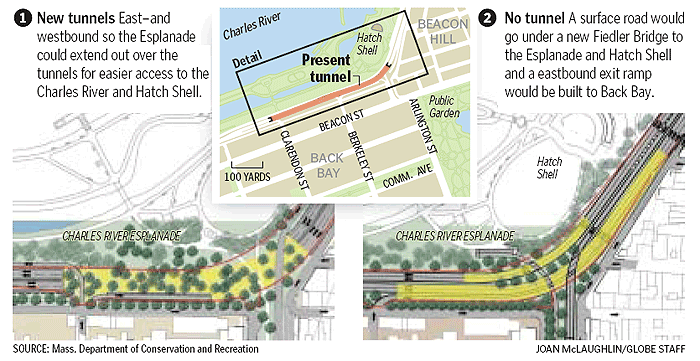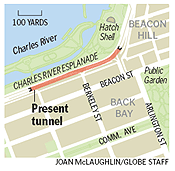czsz
Senior Member
- Joined
- Jan 12, 2007
- Messages
- 6,043
- Reaction score
- 7

Emergency crews work to shore up deteriorating walls and roof of Storrow Drive tunnel almost every night, officials say.
State narrows options on crumbling Storrow Drive tunnel
Officials mull three choices
By Mac Daniel, Globe Staff | June 21, 2007
Forget the ramps from the Massachusetts Turnpike to the Back Bay or the traffic lights on Storrow Drive and other ideas offered as remedies for the ailing Storrow Drive tunnel.
As the design process winds down for a new tunnel, the state Department of Conservation and Recreation's plans for the badly needed project have been whittled down to three options: One would fix the existing tunnel, one would do away with the tunnel, and another would build two smaller tunnels on the east and westbound sides while extending the Esplanade to Back Street.
At a meeting last evening, two advisory committees looked at the latest proposals. The state Highway Department, which will build and pay for the project, favors fixing up the existing tunnel, the least expensive and quickest approach. It would cost $52 million and take a little over two years to finish.
Work on the reconstruction isn't expected to begin until 2010.
"MassHighway is recommending that we rehabilitate the existing tunnel, as it would cause the least amount of disruption in Boston and Cambridge along the Charles River," spokesman John Lamontagne said in a statement.
Despite pressures from local environmental and neighborhood groups to turn Storrow Drive back into a parkway, and from Back Bay neighborhood groups opposed to increased traffic on local streets, the state says it can afford to do only so much with the Storrow Tunnel because it has the $200 million reconstruction of the Longfellow Bridge and the rebuilding of the BU Bridge still to come.
But members of the advisory committees say rebuilding the current tunnel is a short-term approach that would last an estimated 40 years, compared to 70 years for new construction.
"Many of us, myself included, don't want to revisit this issue down the road," said Elliott Laffer , executive director of the Boston Groundwater Trust and chairman of the transportation advisory committee.
DCR officials, however, say the rehabilitation will last 75 years if maintained properly.
Making the tunnel into a surface road would cost about $65 million, according to the figures released yesterday. In the proposed configuration, the westbound entrance from Berkeley Street would close, as would the eastbound exit to Arlington Street. An eastbound exit would be built to Dartmouth Street, where exiting traffic is predicted to almost double. This option would take about 3 1/2 years to construct.
The other option, building two smaller east- and westbound tunnels running about 700 feet each, would cost an estimated $135 million and take more than four years to complete. The existing eastbound exit to Arlington Street would close, an eastbound exit to Dartmouth and Clarendon streets would open, and the existing left-lane westbound exit to Arlington Street would be a right lane exit.
One factor that has stymied both committees are the traffic numbers, which show that at certain points in the day, Storrow Drive carries as much traffic -- 120,000 vehicles per day -- as the parallel section of the Massachusetts Turnpike between downtown Boston and the Fenway/Longwood area. That caused some on the committees to want to ease traffic volume on Storrow and restore its parkway status, an idea that has slowly ebbed as the options dwindle down.
"The committees haven't seen an alternative that met with enough positive answers," Laffer said. "They're being very deliberative, not obstructionist. . . . This is democracy, and democracy is a messy business. It's not a bunch of crazy NIMBY people that just want to make sure they can get to their house. And if that was the kind of process it was, I wouldn't be a part of it."
Two subcommittees studying landscaping and traffic have yet to officially choose an option, though they are slated to do so by July 19.
By July 30, DCR Commissioner Richard Sullivan will make his recommendation, followed by a public comment period. Executive Office of Environmental Affairs Secretary Ian A. Bowles is expected to make his design recommendation by Sept. 14.
Meanwhile, the 56-year-old tunnel continues to crumble. Every night, crews close lanes so they can shore up the wall and roof, which is rusting and bowed but not a safety hazard, officials say.


